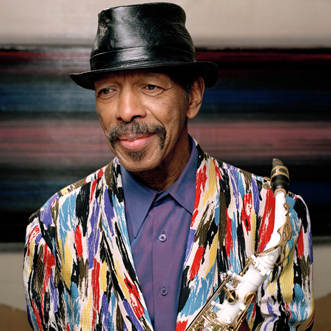
Useful for residents and visitors alike, Barbados Travel Companion, our new travel app to Barbados, supplies comprehensive information along with pictures, maps and links to hundreds of videos and relevant websites.
There is an Android version and an iTunes version.
St. John Visitors:
Please check out Explore St. John, our new travel app to St. John, which supplies comprehensive information (useful for residents and visitors alike) along with pictures, maps and links to hundreds of videos and relevant websites.
Ornette Coleman Live at San Francisco's Symphony Hall
(November 2009)
by Harry S. Pariser
by

There aren’t many 1960s elders of jazz still performing these days. Pianists McCoy Tyner and Randy Weston come to mind, as does saxophonist Sonny Rollins, but few others come to mind. That’s one of the things that made the appearance by Ornette Coleman and his group at the San Francisco Symphony Hall as part of the San Francisco Jazz Festival so compelling.
Despite the demise of longtime collaborators such as trumpeter and multi-instrumentalist Don Cherry and drummer Ed Blackwell and Billy Higgins, Coleman, now 79, keeps on performing. He first came to fame with the release of his controversial album “Free Jazz.” Clocking in at nearly forty minutes and taking up both sides of the album, it was the lengthiest-running jazz composition to have ever been pressed into vinyl. Its release would be followed decades later by rock “jam” releases, such as are represented by the live work of the Allman Brothers and the Grateful Dead, and this tie was perhaps reflected by Jerry Garcia’s playing on two Coleman compositions on a CD, as well as Coleman’s appearances as second on the bill to the Grateful Dead on one of their tours.
As a result of this album, the term “free jazz” came to be applied to all improvisatory jazz forms, something which Coleman was uncomfortable with, probably because his music is composed as well as improvised. Indeed, he is the inventor of a style of music called “harmolodics,” one which Ornette defines as “the use of the physical and the mental of one's own logic made into an expression of sound to bring about the musical sensation of unison executed by a single person or with a group." In terms of his musical compositions and ensemble playing, this means that "harmony, melody, speed, rhythm, time and phrases all have equal position in the results that come from the placing and spacing of ideas."
Ornette was met with standing applause as he took the stage at Symphony Hall. Accompanying him were two bassists: Al Macdowell, a member of Ornette’s 1980s group Prime Time, on electric and Anthony Falanga on acoustic. Coleman’s son Denardo anchored the band with his red drum kit, Denardo first came to public attention when he played drums (at the tender age of ten!) on Ornette’s 1966 trio-date “The Empty Foxhole,” recorded with bassist and longtime collaborator Charlie Haden, The record aroused great controversy because of Denardo’s age and limited skill set. Despite a sometimes critical reception, Denardo has played regularly with Ornette since the late 1970s. (Although this configuration of Ornette’s has been around for some years, it originally had three basses, but Coleman has pared a third bass from the group.)
For this gig, Ornette started with the relatively new composition “Following the Sound” which was in the standard harmolodic mode and characterized by his usual piercing alto. Sixteen succinctly-played compositions (including the encore numbers) followed during the subsequent hour-and-a-half of music. Next up was “Blues Connotation,” from the classic Coleman LP “Following the Sound” which was released a half century ago. This was followed by tunes such as “The Sphinx,” from “Something Else!!!!: The Music of Ornette Coleman,” “Peace" from “The Shape of Jazz to Come,” “Dancing in Your Head” from the Prime Time-era album of the same name, the “Bach Prelude” from “Tone Dialing,” and “Song X,” which was recorded on an album with guitarist Pat Metheny in 1986. While Ornette spent most of his time playing his alto, he also picked up his violin and trumpet on occasion and added them to the sound mix. Much of the musical tension was provided by the contrast between McDowell’s electric bass and Falanga’s acoustic counterpart.
Following a second standing applause, the ensemble returned to play the haunting “Lonely Woman,” arguably Ornette’s best known composition, and then ended the evening with “Jordan” from “Sound Grammar,” the CD which won Coleman a Pulitzer. Characteristically, Ornette had left the stage without ever having said a word to the audience. A third standing ovation ensued.
Useful for residents and visitors alike, Barbados Travel Companion, our new travel app to Barbados, supplies comprehensive information along with pictures, maps and links to hundreds of videos and relevant websites.
There is an Android version and an iTunes version.
St. John Visitors:
Please check out Explore St. John, our new travel app to St. John, which supplies comprehensive information (useful for residents and visitors alike) along with pictures, maps and links to hundreds of videos and relevant websites.
Barbados
| Puerto Rico |
the Virgin Islands | Costa
Rica | Contact
|
Manatees | Tour the Rainforest |
Stock
Photography |
Children's
Coloring Page |
Ordering | Feedback
(Comment Form) | Advertise
| Ask the Manatee
Oracle|
|Links
| This page produced by Harry S. Pariser: Copyright (©) and All Rights Reserved (®). |